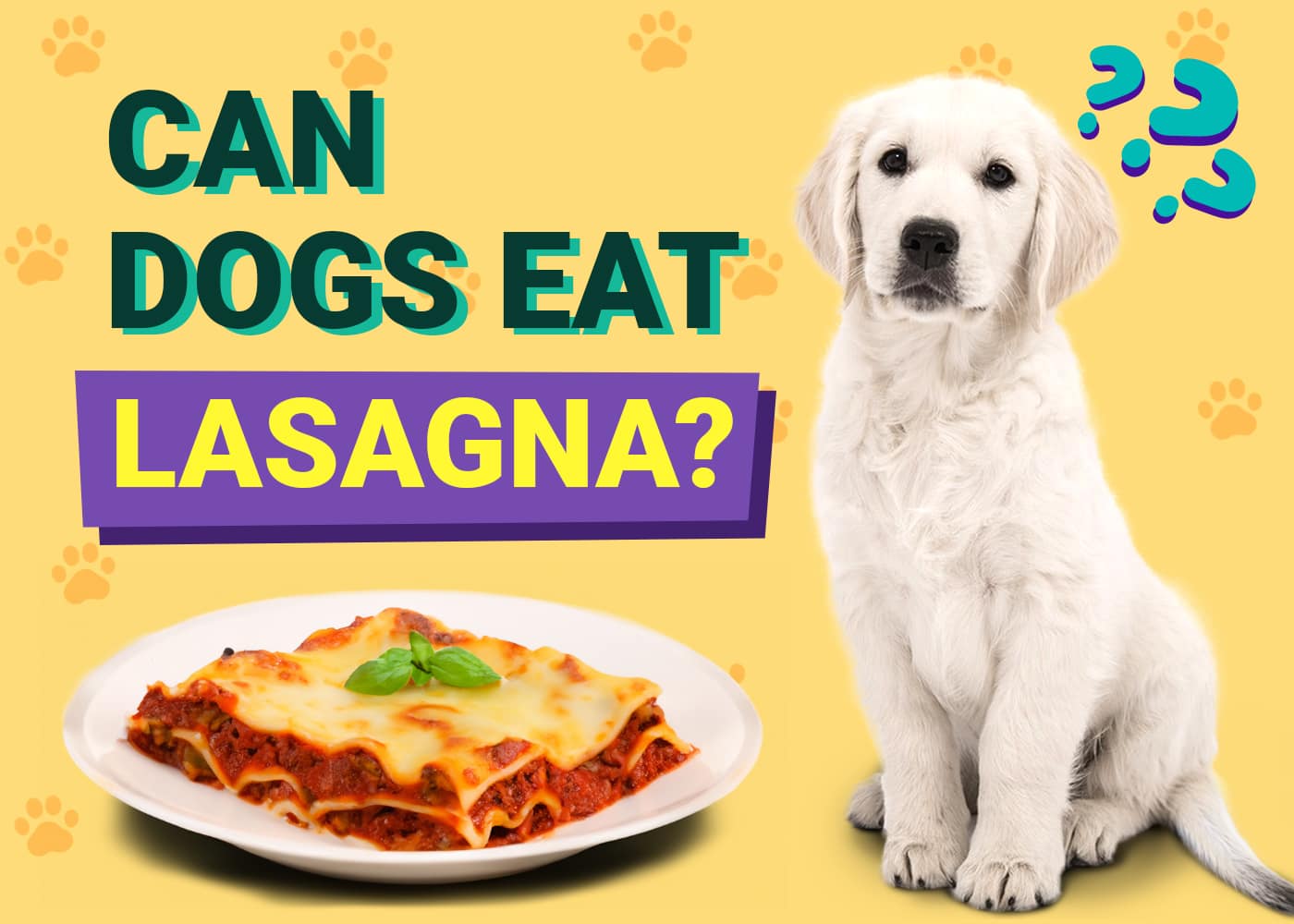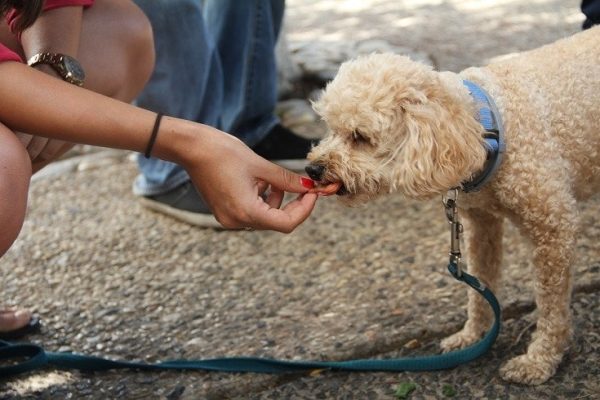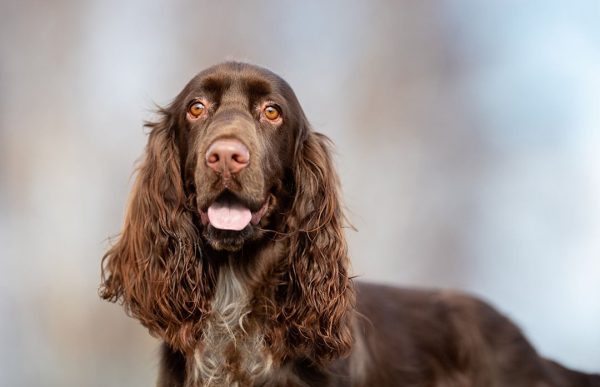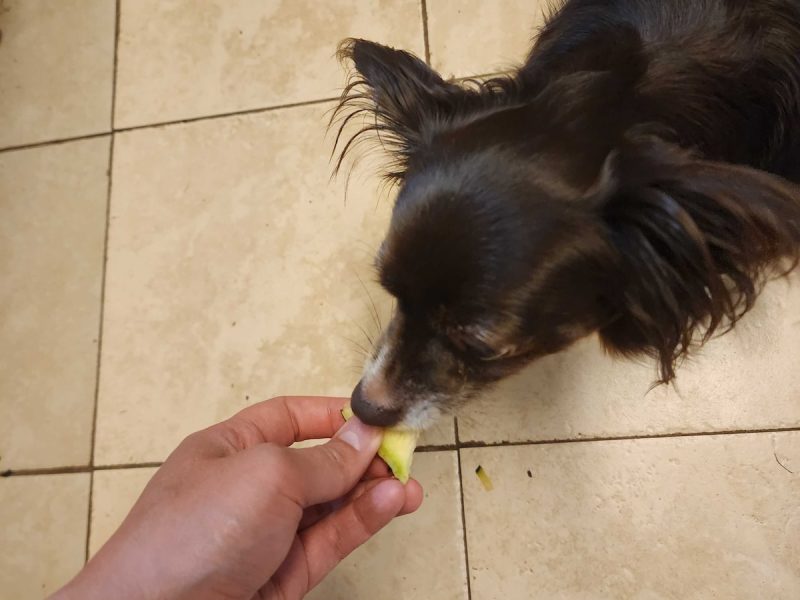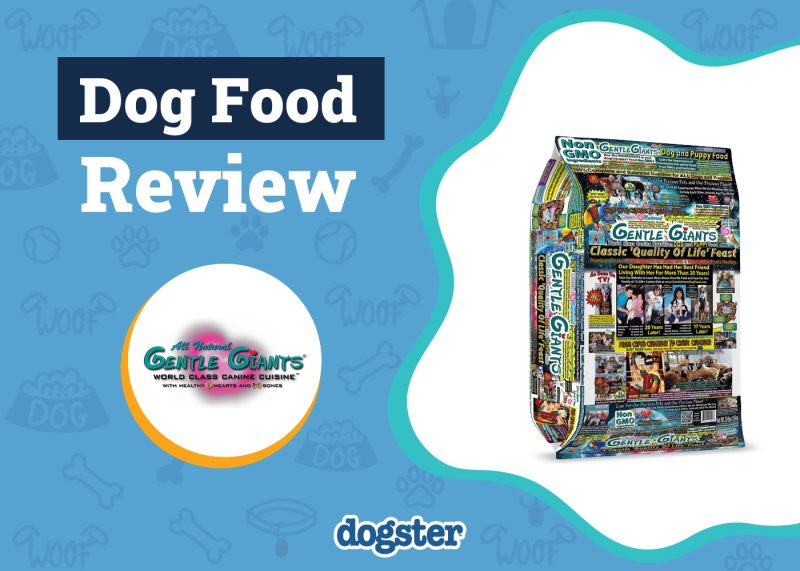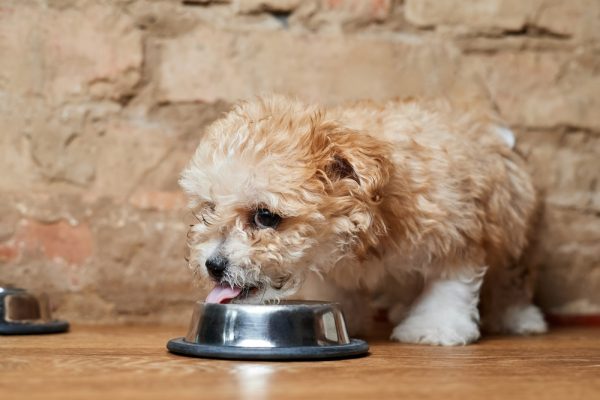If your dog is begging at the dinner table, it is very tempting just to give them a few bites. While there are some human foods dogs can enjoy, lasagna is not one of them. Some of the ingredients inside lasagna aren’t directly toxic for your dog but can still be harmful, while others can lead to severe signs of toxicity. Plus, this food is extremely fatty, and consuming lots of fatty foods over time may lead to obesity and predispose your pup to pancreatitis and diabetes.
If your dog sneaks a few drops of lasagna off the floor, there probably isn’t anything to be worried about. However, problems can arise when your dog consumes more than a few bites. Smaller dogs are more sensitive to the negative effects of lasagna due to their size, though each individual dog will have its own tolerance for all the different ingredients.
Lasagna is both unhealthy and potentially toxic for your dog. Let’s look at some of the reasons why and dive into the troublesome ingredients.
High-Fat
Lasagna often contains many types of cheeses and other fatty ingredients, and too much fat is never a good thing. The recommended daily amount of fat for an adult dog ranges from 5.5 to 15%, depending on their level of activity and general health,1 while in puppies this should be from 10 to 25%.
In the short term, too much fat can lead to stomach upset, vomiting, and diarrhea. Your dog probably isn’t used to consuming lasagna, so their stomach may not know how to handle it. Just like humans, dogs can experience stomach problems when eating new food. The high fat content just makes these symptoms worse.
Also very importantly, consuming too much fatty food over time can predispose your pooch to obesity, pancreatitis, and diabetes.2 Two research studies have identified a potential relationship between obesity and the development of acute inflammation of the pancreas (pancreatitis),3 and being overweight is associated with a 1.3 times increased risk of pancreatitis. There are much safer foods to treat your dog to than lasagna.
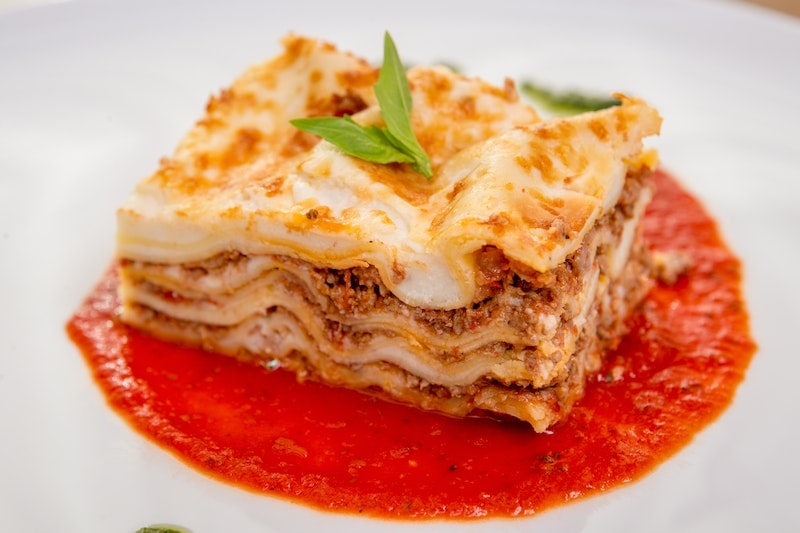
Pancreatitis and Lasagna
The pancreas is vital for digesting large amounts of fat. This small but crucial organ releases enzymes that help your dog break down fatty foods. However, the pancreas can sometimes become inflamed. The inflammation results from the inappropriate, early activation of enzymes within the pancreas itself rather than in the intestine where digestion takes place, which causes the pancreas to digest itself instead of the food. Most cases of pancreatitis in dogs don’t have a clearly identifiable cause, and this is called idiopathic pancreatitis. If a significant number of cells in the pancreas that produce insulin are destroyed in the process, your pooch can develop diabetes. In case of damage to the cells that produce digestive enzymes, your dog could have long-term digestive problems (referred to as exocrine pancreatic insufficiency).
If the pancreas starts leaking enzymes into the surrounding tissues, they can start digesting the cells around them, causing significant inflammation in the dog’s abdomen that in severe cases can lead to shock, sepsis, and death. If the enzymes leak into the bloodstream, they travel throughout the body, and cause damage to other organs like the heart and kidneys. Because the pancreas sits close to the liver and intestines, inflammation of the pancreas frequently affects these organs.
So to conclude, a long-term high-fat diet seems to put dogs at risk of obesity and digestive problems, and pancreatitis is more common in overweight dogs. Therefore, if your canine eats lasagna and other fatty foods, it may put them at a higher risk for this condition.
Sometimes, a fatty meal of lasagna or eating unusual foods scavenged from the trash can trigger pancreatitis in dogs. Other times, pancreatitis may occur out of nowhere.
Onions and Garlic
Both onions and garlic are toxic to dogs and commonly found in lasagna. Luckily, it usually takes a large amount of these ingredients, 15 to 30 g/kg, before your pet develops signs of toxicity. Onion toxicosis is noted in animals that ingest more than 0.5% of their body weight in onions at one time. A relatively high amount (600–800 g) in one meal or spread over a few days can also lead to signs of toxicity.
Pets that consume a lot of human food are most likely to develop toxicity, as they may consume onions and garlic from many different sources. The average dog won’t develop signs of toxicity after eating small amounts of lasagna. However, some dogs may be more sensitive than others, and very small dogs are particularly at risk. Daily feeding of onions from various food sources could have a cumulative effect due to ongoing damage to the red blood cells as the bone marrow might not have enough time to regenerate the prematurely destroyed red cells.
Vomiting and stomach upset may occur as soon as your dog consumes lasagna containing these ingredients. More serious signs often take days to appear. When dogs consume onions and related ingredients, they can damage their red blood cells, preventing them from doing their job of carrying oxygen. When enough red blood cells are damaged, your dog can become anemic. Often, this takes a few days to occur. Certain Japanese dog breeds are at a higher risk for Allium toxicity (a group of plants including garlic, onion, leek, and chives), especially Akitas and Shiba Inus as their red blood cells are different from other breeds.
Signs like an increased heart rate, weakness, labored and fast breathing, pale gums, discolored dark urine, collapse, and seizures can occur. This condition is deadly and requires fast treatment from a vet. Because it takes days for the red blood cells to break down, it can often be hard to pinpoint the cause of the dog’s distress.
Luckily, this condition is somewhat treatable if attended to in time. If the lasagna with garlic or onions was consumed within the last 2 hours at the most, the vet can induce vomiting or use activated charcoal to prevent the onion from being digested. Please never attempt to make your dog vomit at home; this can be dangerous and cause more damage. Kindly bring your dog to the vet. Some dogs may need fluids, oxygen supplementation, or blood transfusions. Many dogs must be hospitalized for monitoring.
If you need to speak with a vet but can't get to one, head over to PangoVet. It's our online service where you can talk to a vet online and get the advice you need for your pet — all at an affordable price!
Can Dogs Eat Lasagna with Ricotta Cheese?
Dogs should never consume lasagna, even if it contains ricotta cheese. Ricotta is a high-fat, lactose-containing cheese that isn’t in itself toxic to dogs. However, it can cause stomach upset due to its high caloric, fat, and carbohydrate content and may lead to obesity, with an increased risk of diabetes and pancreatitis if it’s fed to dogs for an extended period (along with other high-fat foods). Ricotta isn’t necessarily healthy for dogs, though it isn’t blatantly toxic, either. Also, many dogs are lactose intolerant and will develop diarrhea, vomiting, excessive gas, and a painful tummy.
What cheese the lasagna contains also doesn’t change the other ingredients, like onions and garlic.
Therefore, we don’t recommend paying very close attention to what cheese the lasagna contains, as it doesn’t really matter. It’s the fact that the lasagna contains harmful high-fat ingredients like cheese, as well as toxic veggies from the Allium family.
What About Tomato Sauce?
It’s often the tomato sauce in the lasagna that contains onions and garlic. Tomato sauces and ketchup also commonly contain large quantities of sugar, which leads to obesity. A low-calorie or sugar-free sauce may include the artificial sweetener xylitol, which is toxic to dogs. Therefore, tomato sauce isn’t considered safe.
However, if you’re going to cook for your dog, lasagna isn’t the best option. It’s going to be high in fat no matter what you do, which can lead to stomach upset. It also isn’t particularly healthy, so there are no reasons to make a special lasagna for your pet.
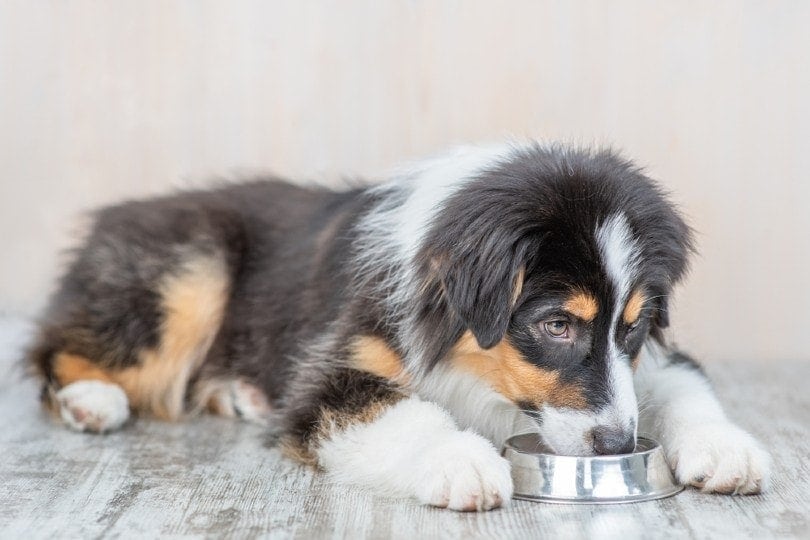
Factors Affecting Toxicity
There are many factors that affect how much lasagna a dog can eat before they develop negative symptoms. Most dogs are fine eating a bit of lasagna once, but some dogs may need fast veterinary care.
Size
Smaller dogs have a lower tolerance for all toxic ingredients due to their smaller body weight. Therefore, you should be extra cautious when your smaller dog consumes lasagna. The smaller the dog, the more at risk they are.
For this reason, we highly recommend that you never feed your smaller dog lasagna (or most other human foods, for that matter), but again, lasagna is not safe for any dog, no matter the size.

Breed
Breeds of Japanese descent are more prone to toxicity caused by onions, garlic, leeks, and similar foods. Therefore, you should speak to your vet right away if these dogs consume vegetables from the Allium family. Early treatment is vital, especially since you do have a few days before serious symptoms start. Your vet can induce vomiting and utilize other methods to reduce negative side effects.
Other Health Issues
If your dog already has health issues, then eating lasagna may make them worse. For instance, dogs that have blood problems, diabetes, organ damage or reduced organ functions, frequent pancreatic issues, sensitive stomach, or food intolerances may be particularly sensitive to the ingredients in lasagna, including lactose, onions, garlic, tomato sauce, and high fat content. Therefore, if your dog has underlying health issues, their situation may be particularly complicated. We highly recommend calling your vet right away, as they can let you know if your dog may be at a higher risk or not.
Conclusion
Lasagna isn’t the best option for your pet for a few different reasons. It’s very high in fat, which can lead to stomach upset and vomiting. A high-fat diet over a longer period of time can lead to obesity, predisposing your dog to diabetes and pancreatitis. Most lasagnas contain garlic and onions, which are toxic to dogs. While a small amount of lasagna won’t include enough to be toxic, it may still harm your dog.
Furthermore, some dogs are more at risk for these problems depending on their general health status and medical history. Those with blood issues may be more at risk for onion and garlic toxicity, especially Japanese dog breeds, as a hereditary condition makes them even more susceptible to developing anemia after consuming onions or garlic.
See also:
- Can Dogs Eat Alfredo Sauce? Vet Reviewed Nutrition Facts
- Can Dogs Eat Couscous? Vet-Reviewed Nutrition Facts & FAQ
Featured Image Credit: footage-kingdom, Pexels
